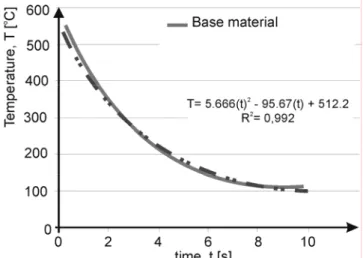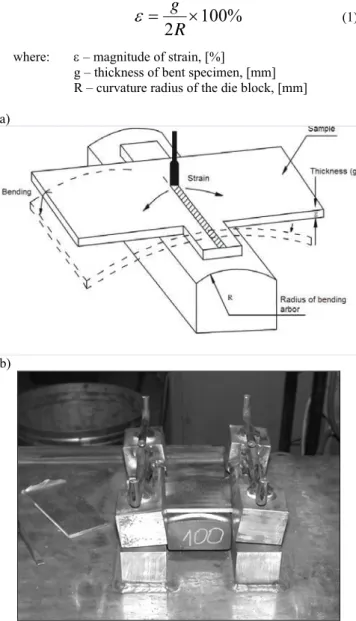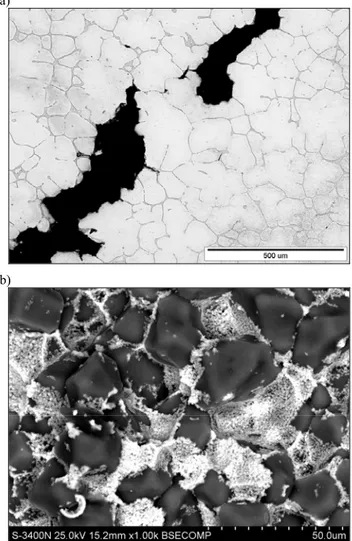A R C H I V E S
o f
F O U N D R Y E N G I N E E R I N G
Published quarterly as the organ of the Foundry Commission of the Polish Academy of Sciences
ISSN (1897-3310)
Volume 10
Issue Special1/2010
345-350
67/1
Evaluation of susceptibility of the ZRE1
alloy to hot cracking in conditions
of forced strain
J. Adamiec
Department of Materials Science,, Silesian University of Technology University,
ul. Krasi
ń
skiego 8, 40-019 Katowice, Poland
*Contact: e-mail: janusz.adamiec@polsl.pl
Received 05.03.2010; accepted in revised form 23.03.2010
Abstract
Nowadays, magnesium alloys are used for casting into sand moulds of huge dimensional castings, high-pressure castings and precise casings. In castings of magnesium alloys defects or inconsistencies often appear (like casting misrun, porosities and cracks) particularly in the huge dimensional castings. Such defects are mended with the use of padding and welding. The welding techniques can be applied by using weld material consisting of magnesium alloy, as well as for regeneration of alloys after excessive wear. Nevertheless, the number of the repaired castings, which were permitted for use, is not satisfactory for a profitable production. The main reasons for wear are the cracks appearing during welding in brittleness high-temperature range.
This work in combination with industrial tests of casting welding show that the causes of high-temperature brittleness are the partial tears of the structure and the hot cracks of both the castings and the welded and padded joints. Such phenomena should be treated as irreversible failures caused by the process of crystallisation that is in the area of co-existence of the solid and liquid structural constituent. The assessment of the resistance to hot fractures was conducted on the basis of the transvarestriant trial. The transvarestriant trial consists in changing of strain during welding It was stated that the range of the high-temperature brittleness is very broad, which significantly limits the application of the welding techniques to join or mend the elements made of alloy ZRE-1. The brittleness is caused mainly by metallurgical factors, i.e., precipitation of inter-metal phases from the solid solution.
Keywords: casting defects, welding of magnesium alloys, hot cracking, ZRE 1, transvarestraint test
1. Introduction
As a result of continuous development, magnesium alloys are now used in many technological areas, and their maximum working temperature is about 250˚C. Particularly important development direction of magnesium alloys is related to the operational temperature of the castings. Attempts are made to increase the creep resistance of magnesium alloys to increase the operational temperature of parts cast from these alloys to above 300 °C (fig. 1) [1,2].
Magnesium alloys are now used to make large-size castings in sand moulds, high-pressure castings and precision castings [3]. Magnesium alloy castings, particularly large-size castings, often
have defects (misruns, micro-shrinkage). In castings of complicated shapes, the defect rate may exceed 50% [4,5]. Such defects are repaired with welding and pad welding. [6]. Amount of repaired magnesium alloy castings and welded structures, which after the repair are approved for use, is unsatisfactory, which often makes production unprofitable. The main reason for this are cracks of castings or structures which develop during the welding process [7-11].
transversal speed of walls movement during welding, depending on wall thickness difference and casting stiffness level [14]. Furthermore, excessive ratio of weld width to its height, and welded joints which are too flat or have concave face cause development of hot cracks in the weld axis [15].
Design factors have been usually omitted during the formulation of hot cracking criteria. As a result, the attempts to use presently formulated criteria to evaluate susceptibility of magnesium alloys to hot cracking are unsuccessful.
The paper presents the influence of forced strain of the weld on susceptibility of the ZRE1 alloy to hot cracking. The results of Transvarestraint test have allowed to determine critical strain rate (CSR), critical strain rate for temperature drop (CST), and to describe temperature brittleness range of the ZRE1 alloy.
Fig. 1. Development direction of magnesium alloys [1].
2. Material for tests
The tests have been performed on the ZRE1 alloy: magnesium cast alloy from the group containing zinc and rare earth elements. Chemical composition and mechanical properties of the alloy in as-delivered state are given in table 1 Comparing the chemical composition with relevant specifications, it was decided that the tested alloy produced by Magnesium Elektron meets the requirements of the BS EN 1753 standard in terms of chemical composition.
3. Determination of typical
temperatures for the process of
crystallization and melting
Typical temperatures for the process of crystallization and melting of the ZRE1 alloy, i.e. temperature of the beginning and the end of crystallization, and melting point for intermetallic phase and the Mg (α) solid solution were determined by differential thermal analysis (DTA). The tests were performed on the SETSYS thermal analyser manufactured by Setaram, using the TG-DTA head. The systems allows measurements of heat flow during phase changes related to melting and crystallization of tested alloys. The measurement of the temperature of the beginning and the end of the change were made with the method of two tangents’ intersection (“one set point”). The conditions of the experiment are given in table 2, and the DTA curves for the ZRE1 alloy during heating and cooling are shown in figure 2.
Table 2. Chemical composition and mechanical properties of the ZRE1 alloy Chemical compostion [%] Alloy
Heat Zn Al Si Cu Mn Fe Ni Zr RE Other
BS EN 1753 2.0-3.0 - - - 0.4-1.0 2.5-4.0 -
ZRE1 20091901 2.8 0.01 <0.01 <0.01 <0.03 0.003 <0.001 0.51 2.87 <0.05 Mechanical properties
Rm [MPa] Re [MPa] A5 [%] HV3
ZRE1 160 110 3 50
Table 3. Heating and cooling conditions during differential thermal analysis for tested magnesium alloys and the test results. Alloy
designation Heating temperature, °C
Heating/ cooling rate
°C/min Atmosphere, % Gas flow speed, l/h
Type of furnace thermocouple
ZRE1 750 10 Ar 99.999 1.45 typ S (Pt-Rh 10%)
Heating
Temperature of beginning of melting of intermetallic phases,
°C
Temperature of end of melting of intermetallic phases, °C
Temperature of beginning of melting of Mg(α) solid
solution, °C
Liquidus temperature, °C
ZRE1 570 616 616 680
Cooling
Temperature of beginning of crystallization of Mg(α)solid
solution, °C
Temperature of end of crystallization of Mg(α)solid
solution, °C
Temperature of beginning of crystallization of intermetallic
phase, °C
Solidus temperature, °C
a)
b)
Fig. 2. DTA curves during heating and cooling of the ZRE1 alloy
The tests of the ZRE1 alloy melting process have shown that in the temperature range from 570 oC to 616 oC, the (Mg,Zn)12RE
intermetallic phase undergoes melting and the (α) solid solution crystals begin to melt (fig. 2a), and that the liquidus temperature is 697 oC. The heat flow analysis during crystallization indicates that the solid solution crystals crystallize at the 658 oC - 598 oC range, and the (Mg,Zn)12RE phase begins to crystallize at 572
o
C. The solidus temperature is 552 oC (fig. 2b).
Analysis of influence of heat flow during melting and crystallization and the DTA curves of magnesium alloys on their structure has been verified on the basis of literature data [2, 3].
4. Simulation of cooling in heat-affected
zone
In order to evaluate the susceptibility to hot cracking in the high-temperature brittleness range, we have determined the changes of temperature of individual points when the alloy was cooled down from the solidus temperature. The tests were performed on the cylindrical Ø 10 x 120 mm specimens, using the Gleeble 3800 simulator, at Iron Metallurgy Institute in Gliwice. Four S-type thermocouples were pressure welded to the specimens: in the specimen axis and 2, 5 and 8 mm away from the axis. The specimens were fixed in copper holders, keeping a constant distance of 33 mm, and then were heated in the argon atmosphere at the 200C/s rate to the temperature of liquid phase appearance, and were afterwards freely cooled. Changes in
temperature in individual points of HAZ were recorded during the experiment. The results were used to formulate equations which describe temperature change over time during the cooling of specimens. Fig. 3 shows the results for tested alloys, for the thermocouple in the melting line, for all heat treatment variants, as well as typical equations for the material in the as-delivered state
Fig. 3. Temperature change over time for the point located on the melting line of the ZRE1 alloy.
The simulation indicates that the relationship which describes the temperature change as a function of time during cooling of the ZRE1 alloy is a polynomial of the second degree (fig. 3).
5. Determination of nil strength
temperature (NST)
The nil strength temperature (NST) for the alloy was determined by testing cylindrical Ø 6 x 90 mm specimens on the Gleeble 3800 simulator. S-type thermocouples were pressure welded to the specimens, and then the specimens were fixed in the chamber by means of copper holders. Constant distance of 52.4 mm was kept between the holders. After evacuation of air, the chamber was filled with argon (to 0.14 hPa). Then, the 0.6 – 0.7 kN minimum pre-load was applied and was maintained until the end of experiment. The specimens were heated at the 20oC/s rate to 400oC, and then at the 1oC/s rate. The NST was determined as the temperature at which the specimen lost its cohesion. The NST for the ZRE1 alloy in as-delivered state is 535 oC.
6. Transvarestraint test
The material welding was preformed with the 130 A alternating current. The welding speed was 1.2 mm/s. The process parameters were selected to obtain full penetration. The magnitude of strain was calculated according to the following formula:
%
100
2
×
=
R
g
ε
(1)where: ε – magnitude of strain, [%]
g – thickness of bent specimen, [mm] R – curvature radius of the die block, [mm]
a)
b)
Fig. 4. Transvarestraint test: a) drawing of the Transvarestraint test, b) test jig built at Department of Materials Science of Silesian Technical University
Subsequently, the following values were determined: length of the longest crack in the weld axis (Lmax), total length of all
cracks (Limax). Knowing the length of crack in the weld axis
(Lmax), corresponding strain, and the welding speed (vs) the crack
development time (tmax) was calculated according to the following
formula:
s
v
L
t
max=
max (2)where: tmax – crack development time, [s], Lmax – longest
crack, [mm], vs – welding speed, [mm/s]
The obtained results were used to determine the high-temperature brittleness range. The range of high-high-temperature brittleness has been determined as a difference between the nil strength temperature (NST) and the temperature of the end of the longest crack (Tk). The determination methodology of
high-temperature brittleness range in conditions of forced strain and the evaluation method of susceptibility of magnesium alloys to hot cracking in the Transvarestraint test are shown in fig. 5.
Fig. 5. The determination methodology of high-temperature brittleness range in conditions of forced strain.
tmax = f(ε) (fig.6a) and to plot the ductility curves ε = f(T) (fig.6b).
Using the regression analysis and correlation of single-variable function, it was determined that the relationships are significant. We also determined the critical strain rate (CSR), understood as the tangent of the inclination angle between the tangent to the crack development curve and the crack development time axis, as well as critical strain rate for temperature drop (CST), which is the tangent of the angle between the tangent to the ductility curve ε = f(T) and the time axis. The calculation results are presented in table 3.
Metallographic tests were performed on the surface perpendicular to the direction of welding and on the surface of the longest crack along the welding direction. Typical weld microstructure and crack surface are shown in fig. 7
Table 3. Results of high-temperature brittleness range (ZKW) evaluation for magnesium alloys in the Transvarestraint test
Alloy CSS, 1/s CST, 1/oC ∆ZKW, oC ZKW, oC
ZRE1 0.11 0.04 342 193-535
a)
b)
Fig. 6. Relationship of crack development time as a function of strain and ductility curve for the ZRE1 alloy: a) tmax = f(ε),
as-delivered state, b) ε = f(T), as-delivered state
a)
b)
Fig. 7. Penetration zone microstructure of the ZRE1 alloy in the Transvarestraint test: a) hot crack with visible bridge, as-delivered state, LM, b) crack surface with precipitation of (Mg,Zn)12RE,
BSE phase
7. Analysis of results
6a). It has been determined that critical strain rate (CSS) for the material in as-delivered state is 0.11 1/s.
The metallographic tests of hot cracks generated during the Transvarestraint test have confirmed that cracking of the alloy in the as-delivered state is caused by melting of the (Mg,Zn)12RE
phase on the borders of crystals, and then the liquid film is torn as a result of forced strain (fig. 7a). This is confirmed by presence of the (Mg,Zn)12RE phase on the crack surface (fig. 7b).
Consequently, on the basis of results of the Transvarestraint test and the metallographic tests, it has been determined that forced strain has a significant influence on susceptibility of the alloy to hot cracking.
8. Conclusions
The performed tests and analysis of results allow formulation of the following conclusions:
• Strain of the ZRE1 castings, typical for the welding and pad welding process, significantly widens the high-temperature brittleness range, by 297 oC in comparison to the high-temperature brittleness range ascertained on the Gleeble simulator. This determines the higher susceptibility of the ZRE1 alloy to hot cracking in conditions of forced strain. • Mathematically described ductility curves ε=f(T) allows
determination and practical use of the CSR and CST ratios in evaluation of susceptibility of magnesium alloys to cracking. • Hot cracking of the ZRE1 alloy develop as a result of melting
of the (Mg,Zn)12RE phase and its loss of cohesion caused by
strains during crystallization of the welded joint.
Acknowledgements
This paper is financed by the Minister of Science and Higher Education as a part of project: PBR-7/RM-7/2008 (N R15-0015-04/2008) “Phenomena occurring during crystallisation of casted magnesium alloys, deciding upon high-temperature brittleness range”.
References
[1]Magnesium alloys and processing technologies for lightweight transport applications – a mission to Europe,
Global Watch Mission Report, MAG TECH 1 september/october 2004
[2]Avedesian M., Baker H., Magnesium and Magnesium Alloys. ASM Speciality Handbook, 1999
[3]Friedrich H.E., Mordike B.L. (Eds), Magnesium Technology. Metallurgy, Design Data, Applications, Springer-Verlag Berlin Heidelberg, 2006
[4]Adamiec J. , Chabko T. : Problems by welding and overlay welding casting of magnesium alloy AZ91D, Spajanie 2/4/2009, 2009, p. 20-23, (in polish)
[5]Adamiec J.: Susceptibility to hot cracking of magnesium alloy ZRE-1 welds Magnesium Alloys and Their Application edited by K.U. Kainer, 2009
[6]Adamiec J., Roskosz S., Jarosz R. : Repair of Magnesium Alloy Castings By Means of Welding and Pad Welding,
Journal of Achievements in Materials and Manufacturing Engineering, vol. 22, issue 1, 2007, p.21-24,
[7]Bollinghaus T., Herold H., Cross C., Lippold J.: Hot cracking phenomena in welds II, rozdz. Katgerman L., Eskin D.G.: In search of the prediction of hot cracking in aluminum alloys, Springer 2008.
[8]Eskin D.G. i in. Mechanical properties in the semi-solid state and hot tearing of aluminium alloys, Progress in Materials Science Volume: 49, Issue: 5, 2004, p. 629-711
[9]Novikov II,Novik FS. Doklady Akad Nauk SSSR,Ser Fiz 1963;7:1153 in Eskin D.G. et al.Mechanical properties in the semi-solid state and hot tearing of aluminium alloys, Progress in Materials Science Volume: 49, Issue: 5, 2004, p. 629-711 [10] Prokhorov NN. The problem of the strength of metals
while solidifying during welding, Svar Proiz 6, p 5-11
[11] Pellini WS. Strain theory of hot tearing, Foundry 1952;80, p. 125-199
[12] Dodd RA.Foundry Trade J 1956:321 w Eskin D.G. et al. Mechanical properties in the semi-solid state and hot tearing of aluminium alloys, Progress in Materials Science Volume: 49, Issue: 5, 2004, p. 629-711
[13] Mordike B.L. Wiesner P.: Fugen von Magnesium Werkstoffen, DVS Verlag 2005
[14] Herold H. Pchennikov A., Steitenberger: Influence of deformation rate of different test on hot cracking formation, Bollinghaus T., Herold H. Hot cracking phenomena in welds, Springer 2005, p 328-346
![Table 2. Chemical composition and mechanical properties of the ZRE1 alloy Chemical compostion [%] Alloy Heat Zn Al Si Cu Mn Fe Ni Zr RE Other BS EN 1753 2.0-3.0 - - - - - - 0.4-1.0 2.5-4.0 - ZRE1 20091901 2.8 0.01 <0.01 <](https://thumb-eu.123doks.com/thumbv2/123dok_br/18440073.363095/2.871.53.815.863.1048/table-chemical-composition-mechanical-properties-chemical-compostion-alloy.webp)


